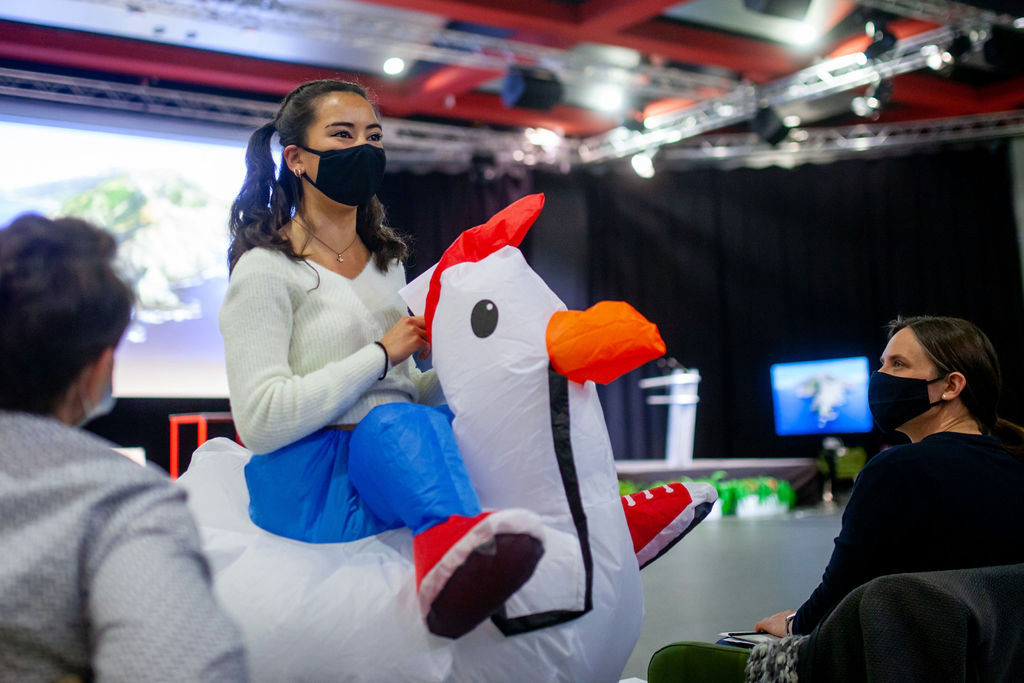When Charlotte’s parents told her that chicken bones could snap in her dog’s mouth causing injuries, this marked the start of a fact-finding mission to discover why the broilers had brittle bones. Her research title “Why couldn’t the chicken cross the road?” is coined after the famous riddle.
Simply put, the chicken didn’t cross the road because it had osteoporosis, a bone disease, says Charlotte. But chickens raised in battery farms are more likely to suffer, the teenager found.
Charlotte, who is also a , submitted her project to the Jonk Fuerscher contest, a national science competition organised by the Fondation Jeunes Scientifiques Luxembourg (FJSL). Convinced by her work, the judges awarded her with a stay in the Swiss alps to take part in the International Wildlife and Research Week to hone her science skills further.
Can you give us a summary of your project ?
In my investigation, I compared the calcium content of bones (tibiotarsus) from chickens raised in battery-farms and chickens raised in open-air farms by using EDTA (an acidic substance) titration. Depending on the farming methods, I analysed and predicted the bones’ strength. To begin with, I crushed the bones, and then placed them in the acid to remove all the calcium and then I calculated the amount of calcium in each of the bones. My results showed that broiler bones from battery farms had an average of 13% calcium, whereas broilers raised in open-air farms had about 19% calcium, signifying that they had stronger bones.
Would you say you are a proponent of a certain breeding method ?
Open-air farms often breed slowly and chickens aren’t confined to cages like in battery farms. This mean they have more access to space and can exercise. Also, you can find information on their diet by labels that breed these kinds. In my experience, this was not the case for most labels with battery farming methods, which often include ad libitum feeding procedures where broilers are fed very quickly. Although this has a financial advantage, the muscles develop faster than the bones and this is a factor that may cause osteoporosis or other kinds of bone deformities.
Besides, the amount of chickens lost through battery farming could still end up as a financial loss as demonstrated by losses of about $4bn dollars from the death of 2% of chickens bred in battery farms. Although the conversion to open-air may take a while and may be costly, I would say I lean more towards open-air farming methods.
What other parameters did you consider? Are your findings transferrable to humans?
It will be interesting to look at human populations, especially places wheres there is a rising level of osteoporosis or an ageing population in general. Before referring to calcium levels, I tried to use bone density, which didn’t show much of a difference. The jury also suggested looking at the mechanical strength of the bone by exerting different forces to see how much force is needed to break each one.
What role do policies have to play ?
In the EU, the so-called “five freedoms” serve as pillars for animal welfare and protect against harmful practices that may be permitted elsewhere. An example would be chicken debeaking (a process of removing chicken beaks), which is a practice allowed in the US. Understanding these differences in legality would be interesting to study in more detail as they impact the health of animals.
Also, there are rising concerns about farm practices globally and I think this is good because it pushes farms to convert to certified labels with predefined standards. These criteria dictate what is permitted, for example, the type of chicken bred (slow or fast-growing), required diet and exercise, timeframe before it is slaughtered…
Did you have help working on this project ?
My chemistry teacher guided me on which substances were allowed to determine PH levels. This project was particularly interesting for me as I had full ownership.
How was the experience during the competition and in the Swiss Alps?
The trip to Val Müstar in the Swiss Alps was a lot of fun. We went in little groups and my group carried out research on two types of venomous snakes that are endangered (aspic viper and common adder). We discovered that due to temperature differences the aspic viper, which is very picky about where they lay their eggs, chose hotter regions that were low in the valley, and to avoid competition the common adder chooses the opposite, i.e higher regions.
For the competition, it was stressful at the beginning and I was nervous at first, but we all had a lot of encouragement from people and in no time you ease into it quickly. The jury was nice but they still asked challenging questions and made useful suggestions. What I found interesting was that they all had very diverse backgrounds--in chemistry, agriculture, anthropology and even computer science--and shared different angles. It did seem more like a conversation in a way.
